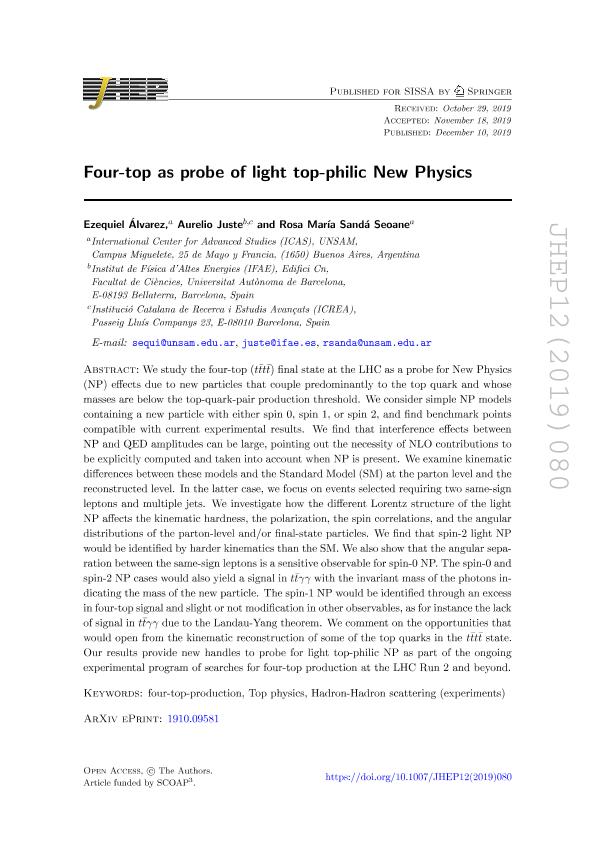Mostrar el registro sencillo del ítem
dc.contributor.author
Alvarez, Ezequiel

dc.contributor.author
Juste, Aurelio
dc.contributor.author
Sandá Seoane, Rosa María

dc.date.available
2023-01-11T10:23:54Z
dc.date.issued
2019-12
dc.identifier.citation
Alvarez, Ezequiel; Juste, Aurelio; Sandá Seoane, Rosa María; Four-top as probe of light top-philic New Physics; Springer; Journal of High Energy Physics; 2019; 12; 12-2019; 1-30
dc.identifier.issn
1126-6708
dc.identifier.uri
http://hdl.handle.net/11336/184253
dc.description.abstract
We study the four-top (tt¯ tt¯) final state at the LHC as a probe for New Physics (NP) effects due to new particles that couple predominantly to the top quark and whose masses are below the top-quark-pair production threshold. We consider simple NP models containing a new particle with either spin 0, spin 1, or spin 2, and find benchmark points compatible with current experimental results. We find that interference effects between NP and QED amplitudes can be large, pointing out the necessity of NLO contributions to be explicitly computed and taken into account when NP is present. We examine kinematic differences between these models and the Standard Model (SM) at the parton level and the reconstructed level. In the latter case, we focus on events selected requiring two same-sign leptons and multiple jets. We investigate how the different Lorentz structure of the light NP affects the kinematic hardness, the polarization, the spin correlations, and the angular distributions of the parton-level and/or final-state particles. We find that spin-2 light NP would be identified by harder kinematics than the SM. We also show that the angular sepa- ration between the same-sign leptons is a sensitive observable for spin-0 NP. The spin-0 and spin-2 NP cases would also yield a signal in tt¯ γγ with the invariant mass of the photons in- dicating the mass of the new particle. The spin-1 NP would be identified through an excess in four-top signal and slight or not modification in other observables, as for instance the lack of signal in tt¯ γγ due to the Landau-Yang theorem. We comment on the opportunities that would open from the kinematic reconstruction of some of the top quarks in the tt¯ tt¯ state. Our results provide new handles to probe for light top-philic NP as part of the ongoing experimental program of searches for four-top production at the LHC Run 2 and beyond.
dc.format
application/pdf
dc.language.iso
eng
dc.publisher
Springer

dc.rights
info:eu-repo/semantics/openAccess
dc.rights.uri
https://creativecommons.org/licenses/by/2.5/ar/
dc.subject
FOUR-TOP-PRODUCTION
dc.subject
HADRON-HADRON SCATTERING (EXPERIMENTS)
dc.subject
TOP PHYSICS
dc.subject.classification
Física de Partículas y Campos

dc.subject.classification
Ciencias Físicas

dc.subject.classification
CIENCIAS NATURALES Y EXACTAS

dc.title
Four-top as probe of light top-philic New Physics
dc.type
info:eu-repo/semantics/article
dc.type
info:ar-repo/semantics/artículo
dc.type
info:eu-repo/semantics/publishedVersion
dc.date.updated
2022-10-27T10:21:19Z
dc.journal.volume
2019
dc.journal.number
12
dc.journal.pagination
1-30
dc.journal.pais
Alemania

dc.description.fil
Fil: Alvarez, Ezequiel. Consejo Nacional de Investigaciones Científicas y Técnicas. Instituto de Ciencias Físicas. - Universidad Nacional de San Martín. Instituto de Ciencias Físicas; Argentina
dc.description.fil
Fil: Juste, Aurelio. Universitat Autònoma de Barcelona; España
dc.description.fil
Fil: Sandá Seoane, Rosa María. Consejo Nacional de Investigaciones Científicas y Técnicas. Instituto de Ciencias Físicas. - Universidad Nacional de San Martín. Instituto de Ciencias Físicas; Argentina
dc.journal.title
Journal of High Energy Physics

dc.relation.alternativeid
info:eu-repo/semantics/altIdentifier/doi/http://dx.doi.org/10.1007/JHEP12(2019)080
Archivos asociados
